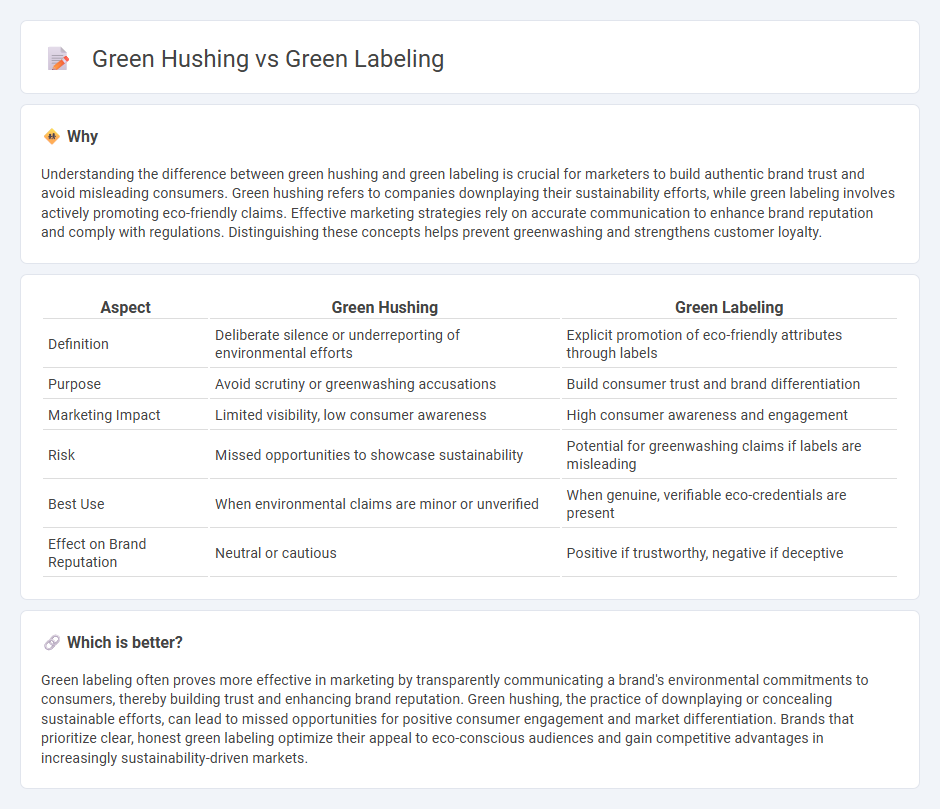
Green hushing occurs when companies intentionally underreport or minimize their environmental initiatives to avoid scrutiny or skepticism, while green labeling involves openly promoting eco-friendly attributes to attract environmentally conscious consumers. Both strategies impact brand reputation and consumer trust but serve different marketing objectives in sustainability communication. Explore further to understand how these approaches shape corporate green marketing strategies and consumer perception.
Why it is important
Understanding the difference between green hushing and green labeling is crucial for marketers to build authentic brand trust and avoid misleading consumers. Green hushing refers to companies downplaying their sustainability efforts, while green labeling involves actively promoting eco-friendly claims. Effective marketing strategies rely on accurate communication to enhance brand reputation and comply with regulations. Distinguishing these concepts helps prevent greenwashing and strengthens customer loyalty.
Comparison Table
| Aspect | Green Hushing | Green Labeling |
|---|---|---|
| Definition | Deliberate silence or underreporting of environmental efforts | Explicit promotion of eco-friendly attributes through labels |
| Purpose | Avoid scrutiny or greenwashing accusations | Build consumer trust and brand differentiation |
| Marketing Impact | Limited visibility, low consumer awareness | High consumer awareness and engagement |
| Risk | Missed opportunities to showcase sustainability | Potential for greenwashing claims if labels are misleading |
| Best Use | When environmental claims are minor or unverified | When genuine, verifiable eco-credentials are present |
| Effect on Brand Reputation | Neutral or cautious | Positive if trustworthy, negative if deceptive |
Which is better?
Green labeling often proves more effective in marketing by transparently communicating a brand's environmental commitments to consumers, thereby building trust and enhancing brand reputation. Green hushing, the practice of downplaying or concealing sustainable efforts, can lead to missed opportunities for positive consumer engagement and market differentiation. Brands that prioritize clear, honest green labeling optimize their appeal to eco-conscious audiences and gain competitive advantages in increasingly sustainability-driven markets.
Connection
Green hushing and green labeling are interconnected marketing strategies impacting brand transparency and consumer trust. While green hushing involves a company deliberately minimizing communication about its environmental efforts to avoid scrutiny, green labeling focuses on prominently showcasing eco-friendly attributes to attract environmentally conscious consumers. Both practices influence consumer perceptions and market positioning within the sustainability-driven marketplace.
Key Terms
Transparency
Green labeling promotes transparency by openly communicating a brand's environmental efforts and certifications, enabling consumers to make informed and eco-conscious choices. In contrast, green hushing involves companies deliberately withholding information about their sustainability practices to avoid scrutiny or backlash, which undermines consumer trust and accountability. Explore effective strategies to balance transparency and credibility in sustainability communications.
Sustainability Claims
Green labeling involves openly communicating a product's sustainability attributes to inform and attract eco-conscious consumers, enhancing transparency and brand trust. Green hushing, on the other hand, refers to the deliberate understatement or silence by companies about their environmental efforts to avoid scrutiny or skepticism. Explore the nuanced impacts of these approaches on consumer perception and corporate responsibility in sustainability claims.
Brand Reputation
Green labeling enhances brand reputation by transparently communicating sustainable practices, attracting eco-conscious consumers and building trust. In contrast, green hushing--deliberate silence about environmental efforts--risks the brand being perceived as non-committal or deceptive, potentially harming credibility. Explore how strategic communication decisions impact your brand's environmental identity and market positioning.
Source and External Links
Ecolabel - Ecolabels are voluntary labeling systems used for food and consumer products to indicate environmental sustainability, with over 456 ecolabels across 25 industry sectors worldwide.
Introduction to Ecolabels and Standards for Greener Products - This webpage explains what ecolabels are and how they help identify environmentally preferable products based on specific performance criteria.
The Green Labeling Phenomenon - It discusses the challenges and trends in environmental claims regulation, including the complexities of scientific uncertainty and terminology in green labeling.
 dowidth.com
dowidth.com